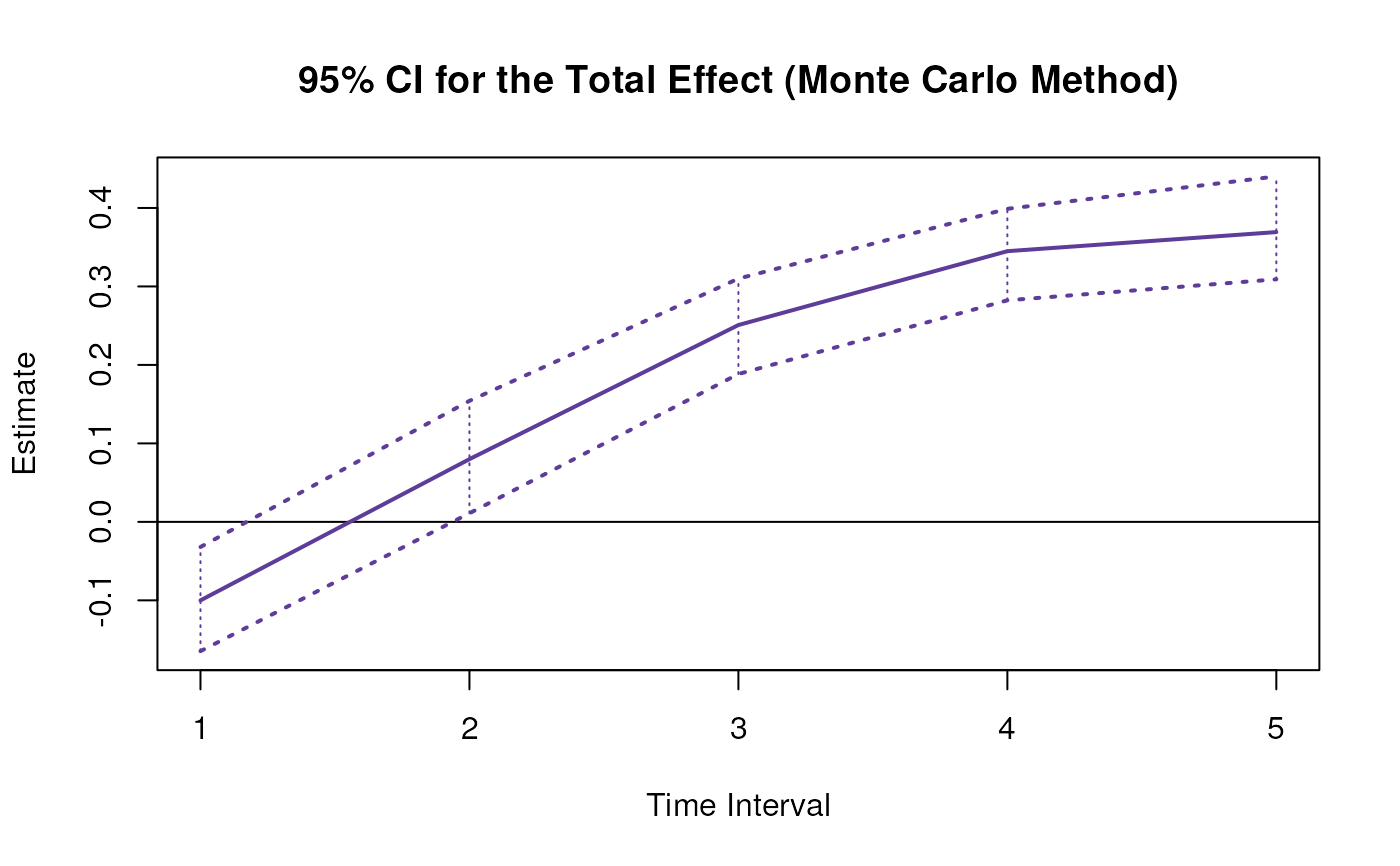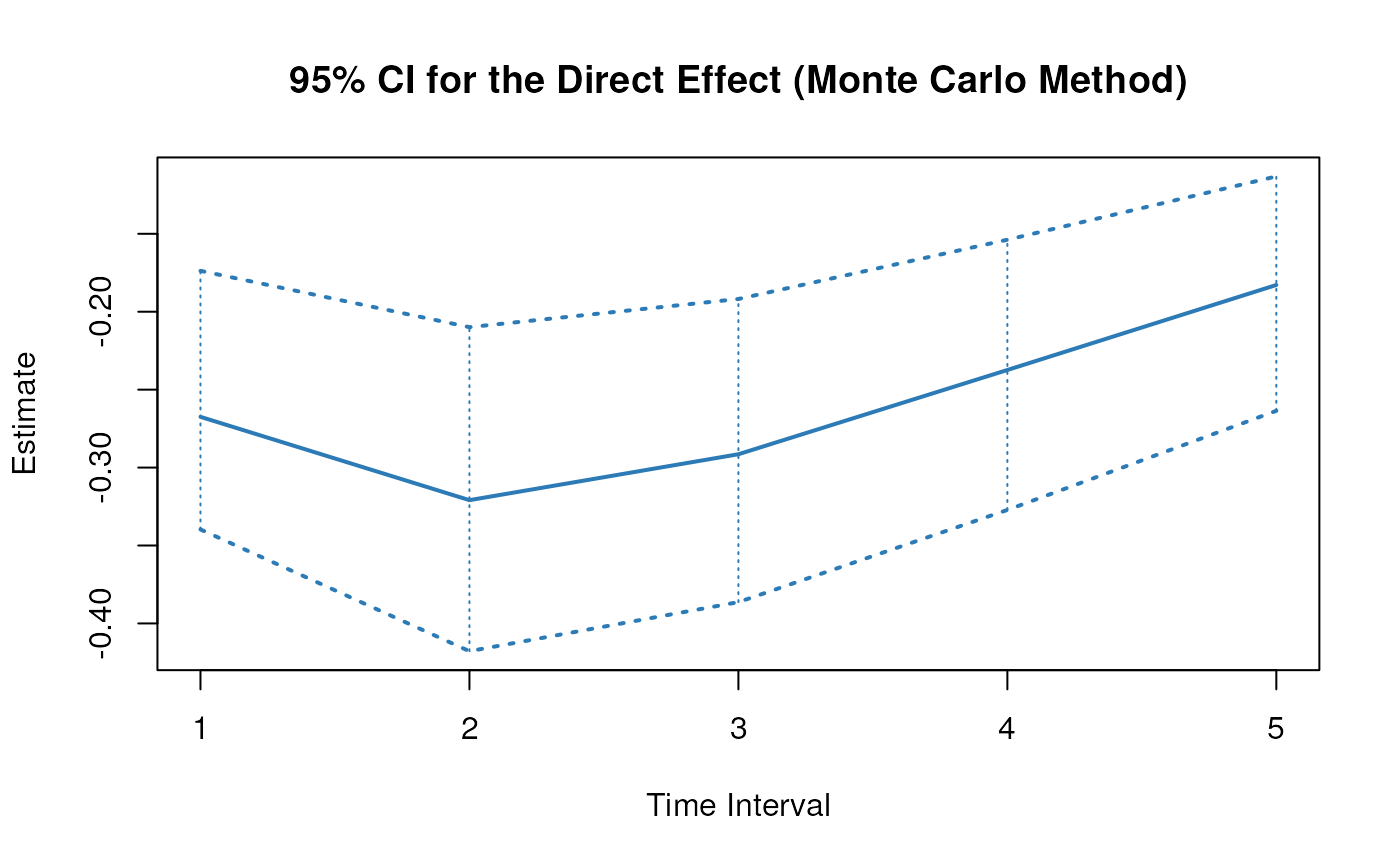Monte Carlo Sampling Distribution of Total, Direct, and Indirect Effects of X on Y Through M Over a Specific Time Interval or a Range of Time Intervals
Source:R/cTMed-mc-med.R
MCMed.RdThis function generates a Monte Carlo method sampling distribution of the total, direct and indirect effects of the independent variable \(X\) on the dependent variable \(Y\) through mediator variables \(\mathbf{m}\) over a specific time interval \(\Delta t\) or a range of time intervals using the first-order stochastic differential equation model drift matrix \(\boldsymbol{\Phi}\).
Usage
MCMed(
phi,
vcov_phi_vec,
delta_t,
from,
to,
med,
R,
test_phi = TRUE,
ncores = NULL,
seed = NULL,
tol = 0.01
)Arguments
- phi
Numeric matrix. The drift matrix (\(\boldsymbol{\Phi}\)).
phishould have row and column names pertaining to the variables in the system.- vcov_phi_vec
Numeric matrix. The sampling variance-covariance matrix of \(\mathrm{vec} \left( \boldsymbol{\Phi} \right)\).
- delta_t
Numeric. Time interval (\(\Delta t\)).
- from
Character string. Name of the independent variable \(X\) in
phi.- to
Character string. Name of the dependent variable \(Y\) in
phi.- med
Character vector. Name/s of the mediator variable/s in
phi.- R
Positive integer. Number of replications.
- test_phi
Logical. If
test_phi = TRUE, the function tests the stability of the generated drift matrix \(\boldsymbol{\Phi}\). If the test returnsFALSE, the function generates a new drift matrix \(\boldsymbol{\Phi}\) and runs the test recursively until the test returnsTRUE.- ncores
Positive integer. Number of cores to use. If
ncores = NULL, use a single core. Consider using multiple cores when number of replicationsRis a large value.- seed
Random seed.
- tol
Numeric. Smallest possible time interval to allow.
Value
Returns an object
of class ctmedmc which is a list with the following elements:
- call
Function call.
- args
Function arguments.
- fun
Function used ("MCMed").
- output
A list with length of
length(delta_t).
Each element in the output list has the following elements:
- est
A vector of total, direct, and indirect effects.
- thetahatstar
A matrix of Monte Carlo total, direct, and indirect effects.
Details
See Total(),
Direct(), and
Indirect() for more details.
Monte Carlo Method
Let \(\boldsymbol{\theta}\) be \(\mathrm{vec} \left( \boldsymbol{\Phi} \right)\), that is, the elements of the \(\boldsymbol{\Phi}\) matrix in vector form sorted column-wise. Let \(\hat{\boldsymbol{\theta}}\) be \(\mathrm{vec} \left( \hat{\boldsymbol{\Phi}} \right)\). Based on the asymptotic properties of maximum likelihood estimators, we can assume that estimators are normally distributed around the population parameters. $$ \hat{\boldsymbol{\theta}} \sim \mathcal{N} \left( \boldsymbol{\theta}, \mathbb{V} \left( \hat{\boldsymbol{\theta}} \right) \right) $$ Using this distributional assumption, a sampling distribution of \(\hat{\boldsymbol{\theta}}\) which we refer to as \(\hat{\boldsymbol{\theta}}^{\ast}\) can be generated by replacing the population parameters with sample estimates, that is, $$ \hat{\boldsymbol{\theta}}^{\ast} \sim \mathcal{N} \left( \hat{\boldsymbol{\theta}}, \hat{\mathbb{V}} \left( \hat{\boldsymbol{\theta}} \right) \right) . $$ Let \(\mathbf{g} \left( \hat{\boldsymbol{\theta}} \right)\) be a parameter that is a function of the estimated parameters. A sampling distribution of \(\mathbf{g} \left( \hat{\boldsymbol{\theta}} \right)\) , which we refer to as \(\mathbf{g} \left( \hat{\boldsymbol{\theta}}^{\ast} \right)\) , can be generated by using the simulated estimates to calculate \(\mathbf{g}\). The standard deviations of the simulated estimates are the standard errors. Percentiles corresponding to \(100 \left( 1 - \alpha \right) \%\) are the confidence intervals.
References
Bollen, K. A. (1987). Total, direct, and indirect effects in structural equation models. Sociological Methodology, 17, 37. doi:10.2307/271028
Deboeck, P. R., & Preacher, K. J. (2015). No need to be discrete: A method for continuous time mediation analysis. Structural Equation Modeling: A Multidisciplinary Journal, 23 (1), 61–75. doi:10.1080/10705511.2014.973960
Pesigan, I. J. A., Russell, M. A., & Chow, S.-M. (2025). Inferences and effect sizes for direct, indirect, and total effects in continuous-time mediation models. Psychological Methods. doi:10.1037/met0000779
Ryan, O., & Hamaker, E. L. (2021). Time to intervene: A continuous-time approach to network analysis and centrality. Psychometrika, 87 (1), 214–252. doi:10.1007/s11336-021-09767-0
See also
Other Continuous-Time Mediation Functions:
BootBeta(),
BootBetaStd(),
BootIndirectCentral(),
BootMed(),
BootMedStd(),
BootTotalCentral(),
DeltaBeta(),
DeltaBetaStd(),
DeltaIndirectCentral(),
DeltaMed(),
DeltaMedStd(),
DeltaTotalCentral(),
Direct(),
DirectStd(),
Indirect(),
IndirectCentral(),
IndirectStd(),
MCBeta(),
MCBetaStd(),
MCIndirectCentral(),
MCMedStd(),
MCPhi(),
MCPhiSigma(),
MCTotalCentral(),
Med(),
MedStd(),
PosteriorBeta(),
PosteriorIndirectCentral(),
PosteriorMed(),
PosteriorTotalCentral(),
Total(),
TotalCentral(),
TotalStd(),
Trajectory()
Examples
set.seed(42)
phi <- matrix(
data = c(
-0.357, 0.771, -0.450,
0.0, -0.511, 0.729,
0, 0, -0.693
),
nrow = 3
)
colnames(phi) <- rownames(phi) <- c("x", "m", "y")
vcov_phi_vec <- matrix(
data = c(
0.00843, 0.00040, -0.00151,
-0.00600, -0.00033, 0.00110,
0.00324, 0.00020, -0.00061,
0.00040, 0.00374, 0.00016,
-0.00022, -0.00273, -0.00016,
0.00009, 0.00150, 0.00012,
-0.00151, 0.00016, 0.00389,
0.00103, -0.00007, -0.00283,
-0.00050, 0.00000, 0.00156,
-0.00600, -0.00022, 0.00103,
0.00644, 0.00031, -0.00119,
-0.00374, -0.00021, 0.00070,
-0.00033, -0.00273, -0.00007,
0.00031, 0.00287, 0.00013,
-0.00014, -0.00170, -0.00012,
0.00110, -0.00016, -0.00283,
-0.00119, 0.00013, 0.00297,
0.00063, -0.00004, -0.00177,
0.00324, 0.00009, -0.00050,
-0.00374, -0.00014, 0.00063,
0.00495, 0.00024, -0.00093,
0.00020, 0.00150, 0.00000,
-0.00021, -0.00170, -0.00004,
0.00024, 0.00214, 0.00012,
-0.00061, 0.00012, 0.00156,
0.00070, -0.00012, -0.00177,
-0.00093, 0.00012, 0.00223
),
nrow = 9
)
# Specific time interval ----------------------------------------------------
MCMed(
phi = phi,
vcov_phi_vec = vcov_phi_vec,
delta_t = 1,
from = "x",
to = "y",
med = "m",
R = 100L # use a large value for R in actual research
)
#> Call:
#> MCMed(phi = phi, vcov_phi_vec = vcov_phi_vec, delta_t = 1, from = "x",
#> to = "y", med = "m", R = 100L)
#>
#> Total, Direct, and Indirect Effects
#>
#> effect interval est se R 2.5% 97.5%
#> 1 total 1 -0.1000 0.0349 100 -0.1728 -0.0344
#> 2 direct 1 -0.2675 0.0454 100 -0.3531 -0.1803
#> 3 indirect 1 0.1674 0.0189 100 0.1310 0.1991
# Range of time intervals ---------------------------------------------------
mc <- MCMed(
phi = phi,
vcov_phi_vec = vcov_phi_vec,
delta_t = 1:5,
from = "x",
to = "y",
med = "m",
R = 100L # use a large value for R in actual research
)
plot(mc)


 # Methods -------------------------------------------------------------------
# MCMed has a number of methods including
# print, summary, confint, and plot
print(mc)
#> Call:
#> MCMed(phi = phi, vcov_phi_vec = vcov_phi_vec, delta_t = 1:5,
#> from = "x", to = "y", med = "m", R = 100L)
#>
#> Total, Direct, and Indirect Effects
#>
#> effect interval est se R 2.5% 97.5%
#> 1 total 1 -0.1000 0.0283 100 -0.1523 -0.0412
#> 2 direct 1 -0.2675 0.0379 100 -0.3410 -0.1958
#> 3 indirect 1 0.1674 0.0181 100 0.1303 0.1973
#> 4 total 2 0.0799 0.0318 100 0.0173 0.1382
#> 5 direct 2 -0.3209 0.0533 100 -0.4335 -0.2250
#> 6 indirect 2 0.4008 0.0472 100 0.3209 0.4844
#> 7 total 3 0.2508 0.0341 100 0.1789 0.3160
#> 8 direct 3 -0.2914 0.0600 100 -0.4250 -0.1953
#> 9 indirect 3 0.5423 0.0723 100 0.4313 0.6825
#> 10 total 4 0.3449 0.0396 100 0.2776 0.4253
#> 11 direct 4 -0.2374 0.0614 100 -0.3713 -0.1499
#> 12 indirect 4 0.5823 0.0888 100 0.4543 0.7487
#> 13 total 5 0.3693 0.0454 100 0.3097 0.4771
#> 14 direct 5 -0.1828 0.0592 100 -0.3156 -0.1139
#> 15 indirect 5 0.5521 0.0964 100 0.4232 0.7533
summary(mc)
#> Call:
#> MCMed(phi = phi, vcov_phi_vec = vcov_phi_vec, delta_t = 1:5,
#> from = "x", to = "y", med = "m", R = 100L)
#>
#> Total, Direct, and Indirect Effects
#>
#> effect interval est se R 2.5% 97.5%
#> 1 total 1 -0.1000 0.0283 100 -0.1523 -0.0412
#> 2 direct 1 -0.2675 0.0379 100 -0.3410 -0.1958
#> 3 indirect 1 0.1674 0.0181 100 0.1303 0.1973
#> 4 total 2 0.0799 0.0318 100 0.0173 0.1382
#> 5 direct 2 -0.3209 0.0533 100 -0.4335 -0.2250
#> 6 indirect 2 0.4008 0.0472 100 0.3209 0.4844
#> 7 total 3 0.2508 0.0341 100 0.1789 0.3160
#> 8 direct 3 -0.2914 0.0600 100 -0.4250 -0.1953
#> 9 indirect 3 0.5423 0.0723 100 0.4313 0.6825
#> 10 total 4 0.3449 0.0396 100 0.2776 0.4253
#> 11 direct 4 -0.2374 0.0614 100 -0.3713 -0.1499
#> 12 indirect 4 0.5823 0.0888 100 0.4543 0.7487
#> 13 total 5 0.3693 0.0454 100 0.3097 0.4771
#> 14 direct 5 -0.1828 0.0592 100 -0.3156 -0.1139
#> 15 indirect 5 0.5521 0.0964 100 0.4232 0.7533
confint(mc, level = 0.95)
#> effect interval 2.5 % 97.5 %
#> 1 total 1 -0.15232781 -0.04123191
#> 2 direct 1 -0.34098924 -0.19575030
#> 3 indirect 1 0.13034214 0.19730024
#> 4 total 2 0.01734713 0.13816481
#> 5 direct 2 -0.43347383 -0.22496835
#> 6 indirect 2 0.32090375 0.48438931
#> 7 total 3 0.17891544 0.31595326
#> 8 direct 3 -0.42496332 -0.19529856
#> 9 indirect 3 0.43134204 0.68245524
#> 10 total 4 0.27762014 0.42528849
#> 11 direct 4 -0.37132486 -0.14987686
#> 12 indirect 4 0.45427525 0.74867661
#> 13 total 5 0.30966378 0.47707320
#> 14 direct 5 -0.31560524 -0.11390776
#> 15 indirect 5 0.42321469 0.75325267
# Methods -------------------------------------------------------------------
# MCMed has a number of methods including
# print, summary, confint, and plot
print(mc)
#> Call:
#> MCMed(phi = phi, vcov_phi_vec = vcov_phi_vec, delta_t = 1:5,
#> from = "x", to = "y", med = "m", R = 100L)
#>
#> Total, Direct, and Indirect Effects
#>
#> effect interval est se R 2.5% 97.5%
#> 1 total 1 -0.1000 0.0283 100 -0.1523 -0.0412
#> 2 direct 1 -0.2675 0.0379 100 -0.3410 -0.1958
#> 3 indirect 1 0.1674 0.0181 100 0.1303 0.1973
#> 4 total 2 0.0799 0.0318 100 0.0173 0.1382
#> 5 direct 2 -0.3209 0.0533 100 -0.4335 -0.2250
#> 6 indirect 2 0.4008 0.0472 100 0.3209 0.4844
#> 7 total 3 0.2508 0.0341 100 0.1789 0.3160
#> 8 direct 3 -0.2914 0.0600 100 -0.4250 -0.1953
#> 9 indirect 3 0.5423 0.0723 100 0.4313 0.6825
#> 10 total 4 0.3449 0.0396 100 0.2776 0.4253
#> 11 direct 4 -0.2374 0.0614 100 -0.3713 -0.1499
#> 12 indirect 4 0.5823 0.0888 100 0.4543 0.7487
#> 13 total 5 0.3693 0.0454 100 0.3097 0.4771
#> 14 direct 5 -0.1828 0.0592 100 -0.3156 -0.1139
#> 15 indirect 5 0.5521 0.0964 100 0.4232 0.7533
summary(mc)
#> Call:
#> MCMed(phi = phi, vcov_phi_vec = vcov_phi_vec, delta_t = 1:5,
#> from = "x", to = "y", med = "m", R = 100L)
#>
#> Total, Direct, and Indirect Effects
#>
#> effect interval est se R 2.5% 97.5%
#> 1 total 1 -0.1000 0.0283 100 -0.1523 -0.0412
#> 2 direct 1 -0.2675 0.0379 100 -0.3410 -0.1958
#> 3 indirect 1 0.1674 0.0181 100 0.1303 0.1973
#> 4 total 2 0.0799 0.0318 100 0.0173 0.1382
#> 5 direct 2 -0.3209 0.0533 100 -0.4335 -0.2250
#> 6 indirect 2 0.4008 0.0472 100 0.3209 0.4844
#> 7 total 3 0.2508 0.0341 100 0.1789 0.3160
#> 8 direct 3 -0.2914 0.0600 100 -0.4250 -0.1953
#> 9 indirect 3 0.5423 0.0723 100 0.4313 0.6825
#> 10 total 4 0.3449 0.0396 100 0.2776 0.4253
#> 11 direct 4 -0.2374 0.0614 100 -0.3713 -0.1499
#> 12 indirect 4 0.5823 0.0888 100 0.4543 0.7487
#> 13 total 5 0.3693 0.0454 100 0.3097 0.4771
#> 14 direct 5 -0.1828 0.0592 100 -0.3156 -0.1139
#> 15 indirect 5 0.5521 0.0964 100 0.4232 0.7533
confint(mc, level = 0.95)
#> effect interval 2.5 % 97.5 %
#> 1 total 1 -0.15232781 -0.04123191
#> 2 direct 1 -0.34098924 -0.19575030
#> 3 indirect 1 0.13034214 0.19730024
#> 4 total 2 0.01734713 0.13816481
#> 5 direct 2 -0.43347383 -0.22496835
#> 6 indirect 2 0.32090375 0.48438931
#> 7 total 3 0.17891544 0.31595326
#> 8 direct 3 -0.42496332 -0.19529856
#> 9 indirect 3 0.43134204 0.68245524
#> 10 total 4 0.27762014 0.42528849
#> 11 direct 4 -0.37132486 -0.14987686
#> 12 indirect 4 0.45427525 0.74867661
#> 13 total 5 0.30966378 0.47707320
#> 14 direct 5 -0.31560524 -0.11390776
#> 15 indirect 5 0.42321469 0.75325267